FIAT PUNTO 2020 Owner handbook (in English)
Manufacturer: FIAT, Model Year: 2020, Model line: PUNTO, Model: FIAT PUNTO 2020Pages: 219, PDF Size: 9.82 MB
Page 181 of 219
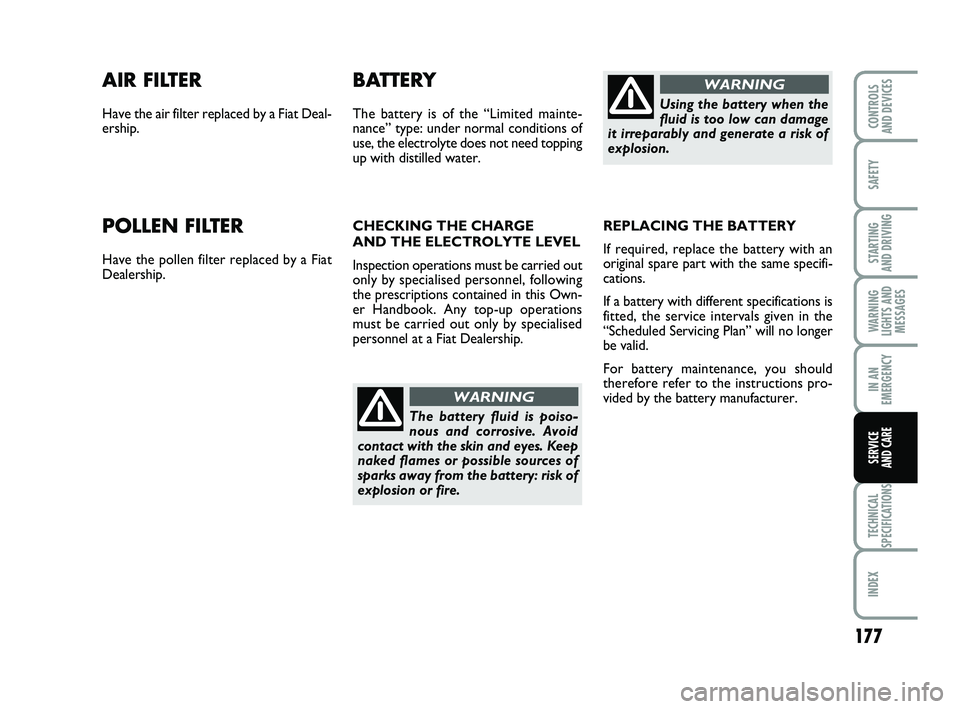
177
SAFETY
STARTING
AND DRIVING
WARNING
LIGHTS AND MESSAGES
IN AN
EMERGENCY
TECHNICAL
SPECIFICATIONS
INDEX
CONTROLS
AND DEVICES
SERVICE
AND CARE
AIR FILTER
Have the air filter replaced by a Fiat Deal-
ership.
POLLEN FILTER
Have the pollen filter replaced by a Fiat
Dealership.
BATTERY
The battery is of the “Limited mainte-
nance” type: under normal conditions of
use, the electrolyte does not need topping
up with distilled water.
The battery fluid is poiso-
nous and corrosive. Avoid
contact with the skin and eyes. Keep
naked flames or possible sources of
sparks away from the battery: risk of
explosion or fire.
WARNING
CHECKING THE CHARGE
AND THE ELECTROLYTE LEVEL
Inspection operations must be carried out
only by specialised personnel, following
the prescriptions contained in this Own-
er Handbook. Any top-up operations
must be carried out only by specialised
personnel at a Fiat Dealership.
Using the battery when the
fluid is too low can damage
it irreparably and generate a risk of
explosion.
WARNING
REPLACING THE BATTERY
If required, replace the battery with an
original spare part with the same specifi-
cations.
If a battery with different specifications is
fitted, the service intervals given in the
“Scheduled Servicing Plan” will no longer
be valid.
For battery maintenance, you should
therefore refer to the instructions pro-
vided by the battery manufacturer.
165-184 PUNTO POP 1ed EN 07/04/14 09:35 Pagina 177
Page 182 of 219
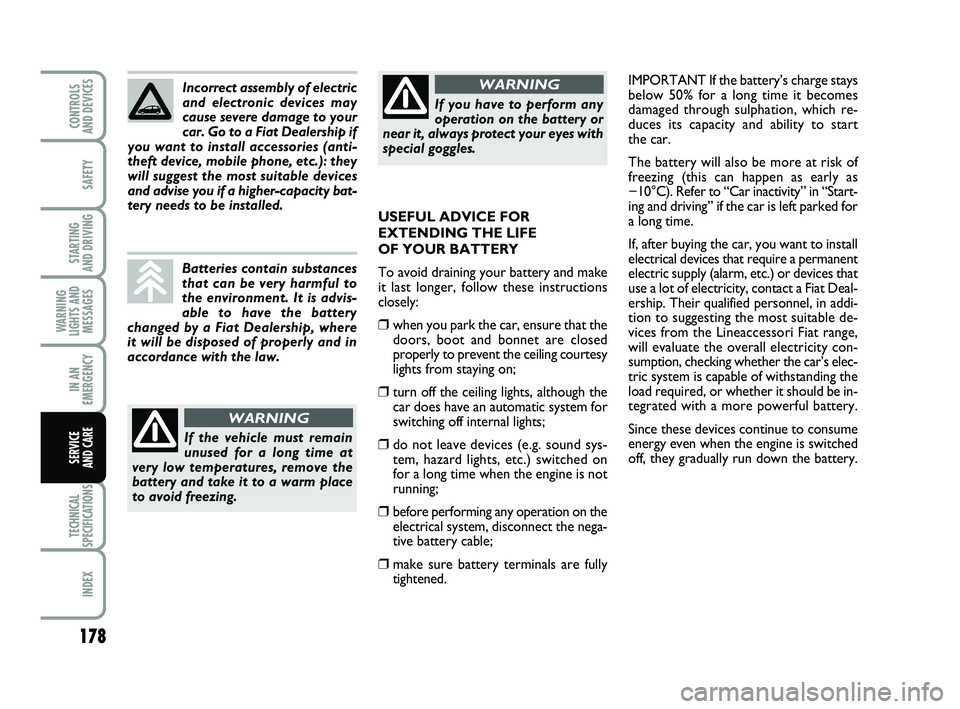
178
SAFETY
STARTING
AND DRIVING
WARNING
LIGHTS AND MESSAGES
IN AN
EMERGENCY
TECHNICAL
SPECIFICATIONS
INDEX
CONTROLS
AND DEVICES
SERVICE
AND CARE
IMPORTANT If the battery’s charge stays
below 50% for a long time it becomes
damaged through sulphation, which re-
duces its capacity and ability to start
the car.
The battery will also be more at risk of
freezing (this can happen as early as
−10°C). Refer to “Car inactivity” in “Start-
ing and driving” if the car is left parked for
a long time.
If, after buying the car, you want to install
electrical devices that require a permanent
electric supply (alarm, etc.) or devices that
use a lot of electricity, contact a Fiat Deal-
ership. Their qualified personnel, in addi-
tion to suggesting the most suitable de-
vices from the Lineaccessori Fiat range,
will evaluate the overall electricity con-
sumption, checking whether the car’s elec-
tric system is capable of withstanding the
load required, or whether it should be in-
tegrated with a more powerful battery.
Since these devices continue to consume
energy even when the engine is switched
off, they gradually run down the battery.
USEFUL ADVICE FOR
EXTENDING THE LIFE
OF YOUR BATTERY
To avoid draining your battery and make
it last longer, follow these instructions
closely:
❒when you park the car, ensure that the
doors, boot and bonnet are closed
properly to prevent the ceiling courtesy
lights from staying on;
❒turn off the ceiling lights, although thecar does have an automatic system for
switching off internal lights;
❒do not leave devices (e.g. sound sys-tem, hazard lights, etc.) switched on
for a long time when the engine is not
running;
❒before performing any operation on theelectrical system, disconnect the nega-
tive battery cable;
❒make sure battery terminals are fullytightened.
Incorrect assembly of electric
and electronic devices may
cause severe damage to your
car. Go to a Fiat Dealership if
you want to install accessories (anti-
theft device, mobile phone, etc.): they
will suggest the most suitable devices
and advise you if a higher-capacity bat-
tery needs to be installed.
Batteries contain substances
that can be very harmful to
the environment. It is advis-
able to have the battery
changed by a Fiat Dealership, where
it will be disposed of properly and in
accordance with the law.
If the vehicle must remain
unused for a long time at
very low temperatures, remove the
battery and take it to a warm place
to avoid freezing.
WARNING
If you have to perform any
operation on the battery or
near it, always protect your eyes with
special goggles.
WARNING
165-184 PUNTO POP 1ed EN 07/04/14 09:35 Pagina 178
Page 183 of 219
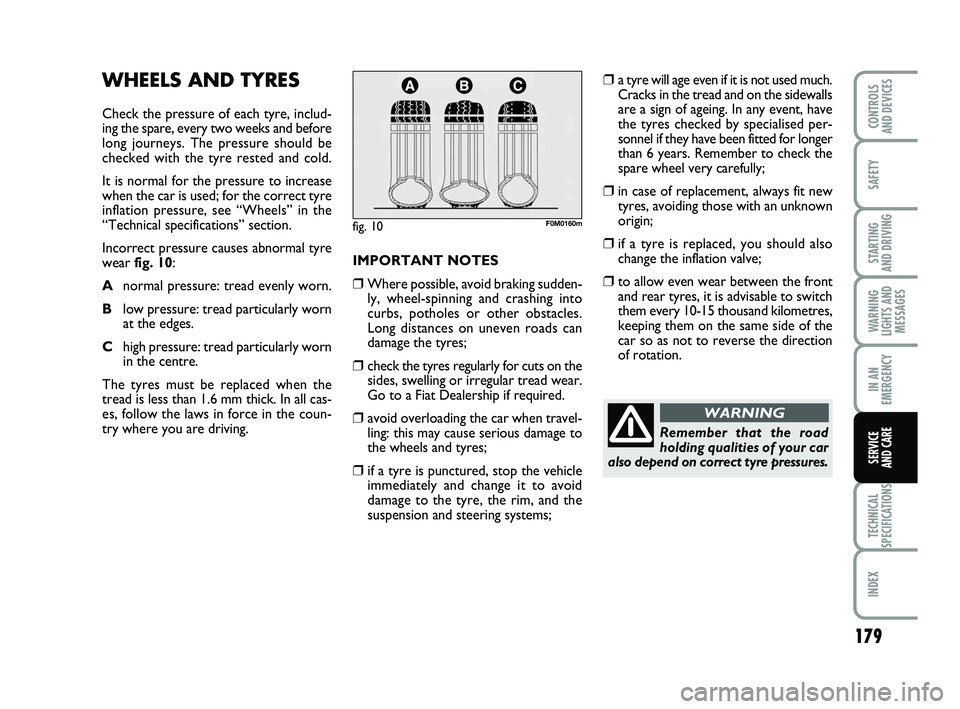
179
SAFETY
STARTING
AND DRIVING
WARNING
LIGHTS AND MESSAGES
IN AN
EMERGENCY
TECHNICAL
SPECIFICATIONS
INDEX
CONTROLS
AND DEVICES
SERVICE
AND CARE
WHEELS AND TYRES
Check the pressure of each tyre, includ-
ing the spare, every two weeks and before
long journeys. The pressure should be
checked with the tyre rested and cold.
It is normal for the pressure to increase
when the car is used; for the correct tyre
inflation pressure, see “Wheels” in the
“Technical specifications” section.
Incorrect pressure causes abnormal tyre
wear fig. 10:
A normal pressure: tread evenly worn.
B low pressure: tread particularly worn
at the edges.
C high pressure: tread particularly worn
in the centre.
The tyres must be replaced when the
tread is less than 1.6 mm thick. In all cas-
es, follow the laws in force in the coun-
try where you are driving.
fig. 10F0M0160m
IMPORTANT NOTES
❒Where possible, avoid braking sudden- ly, wheel-spinning and crashing into
curbs, potholes or other obstacles.
Long distances on uneven roads can
damage the tyres;
❒check the tyres regularly for cuts on thesides, swelling or irregular tread wear.
Go to a Fiat Dealership if required.
❒avoid overloading the car when travel-ling: this may cause serious damage to
the wheels and tyres;
❒if a tyre is punctured, stop the vehicleimmediately and change it to avoid
damage to the tyre, the rim, and the
suspension and steering systems;
❒a tyre will age even if it is not used much.Cracks in the tread and on the sidewalls
are a sign of ageing. In any event, have
the tyres checked by specialised per-
sonnel if they have been fitted for longer
than 6 years. Remember to check the
spare wheel very carefully;
❒in case of replacement, always fit newtyres, avoiding those with an unknown
origin;
❒if a tyre is replaced, you should alsochange the inflation valve;
❒to allow even wear between the front
and rear tyres, it is advisable to switch
them every 10-15 thousand kilometres,
keeping them on the same side of the
car so as not to reverse the direction
of rotation.
Remember that the road
holding qualities of your car
also depend on correct tyre pressures.
WARNING
165-184 PUNTO POP 1ed EN 07/04/14 09:35 Pagina 179
Page 184 of 219
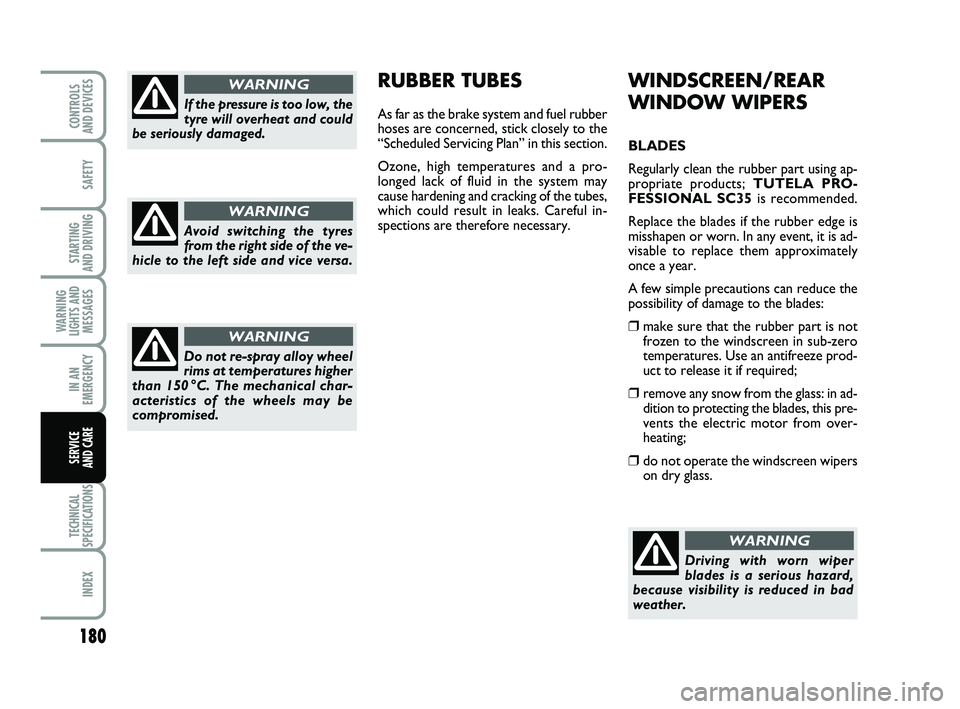
180
SAFETY
STARTING
AND DRIVING
WARNING
LIGHTS AND MESSAGES
IN AN
EMERGENCY
TECHNICAL
SPECIFICATIONS
INDEX
CONTROLS
AND DEVICES
SERVICE
AND CARE
WINDSCREEN/REAR
WINDOW WIPERS
BLADES
Regularly clean the rubber part using ap-
propriate products; TUTELA PRO-
FESSIONAL SC35 is recommended.
Replace the blades if the rubber edge is
misshapen or worn. In any event, it is ad-
visable to replace them approximately
once a year.
A few simple precautions can reduce the
possibility of damage to the blades:
❒make sure that the rubber part is not
frozen to the windscreen in sub-zero
temperatures. Use an antifreeze prod-
uct to release it if required;
❒remove any snow from the glass: in ad-
dition to protecting the blades, this pre-
vents the electric motor from over-
heating;
❒do not operate the windscreen wipers
on dry glass.
Driving with worn wiper
blades is a serious hazard,
because visibility is reduced in bad
weather.
WARNING
RUBBER TUBES
As far as the brake system and fuel rubber
hoses are concerned, stick closely to the
“Scheduled Servicing Plan” in this section.
Ozone, high temperatures and a pro-
longed lack of fluid in the system may
cause hardening and cracking of the tubes,
which could result in leaks. Careful in-
spections are therefore necessary.If the pressure is too low, the
tyre will overheat and could
be seriously damaged.
WARNING
Avoid switching the tyres
from the right side of the ve-
hicle to the left side and vice versa.
WARNING
Do not re-spray alloy wheel
rims at temperatures higher
than 150 °C. The mechanical char-
acteristics of the wheels may be
compromised.
WARNING
165-184 PUNTO POP 1ed EN 07/04/14 09:35 Pagina 180
Page 185 of 219
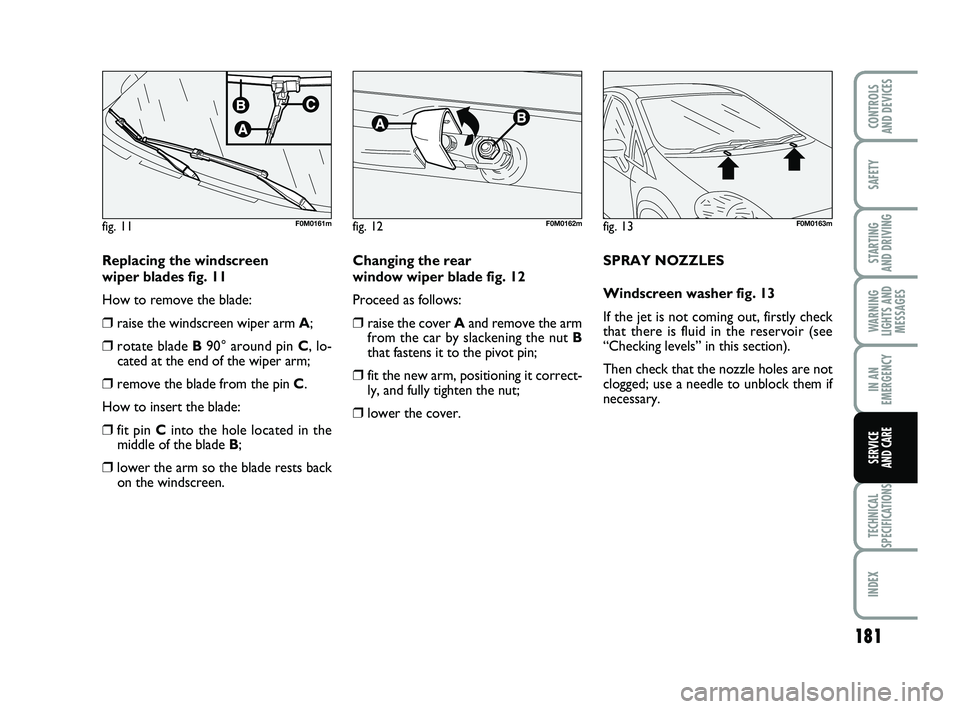
181
SAFETY
STARTING
AND DRIVING
WARNING
LIGHTS AND MESSAGES
IN AN
EMERGENCY
TECHNICAL
SPECIFICATIONS
INDEX
CONTROLS
AND DEVICES
SERVICE
AND CARE
Replacing the windscreen
wiper blades fig. 11
How to remove the blade:
❒raise the windscreen wiper arm A;
❒rotate blade B 90° around pin C , lo-
cated at the end of the wiper arm;
❒remove the blade from the pin C.
How to insert the blade:
❒fit pin C into the hole located in the
middle of the blade B;
❒lower the arm so the blade rests back
on the windscreen.
fig. 11F0M0161m
Changing the rear
window wiper blade fig. 12
Proceed as follows:
❒raise the cover A and remove the arm
from the car by slackening the nut B
that fastens it to the pivot pin;
❒fit the new arm, positioning it correct- ly, and fully tighten the nut;
❒lower the cover.
fig. 12F0M0162m
SPRAY NOZZLES
Windscreen washer fig. 13
If the jet is not coming out, firstly check
that there is fluid in the reservoir (see
“Checking levels” in this section).
Then check that the nozzle holes are not
clogged; use a needle to unblock them if
necessary.
fig. 13F0M0163m
165-184 PUNTO POP 1ed EN 07/04/14 09:35 Pagina 181
Page 186 of 219
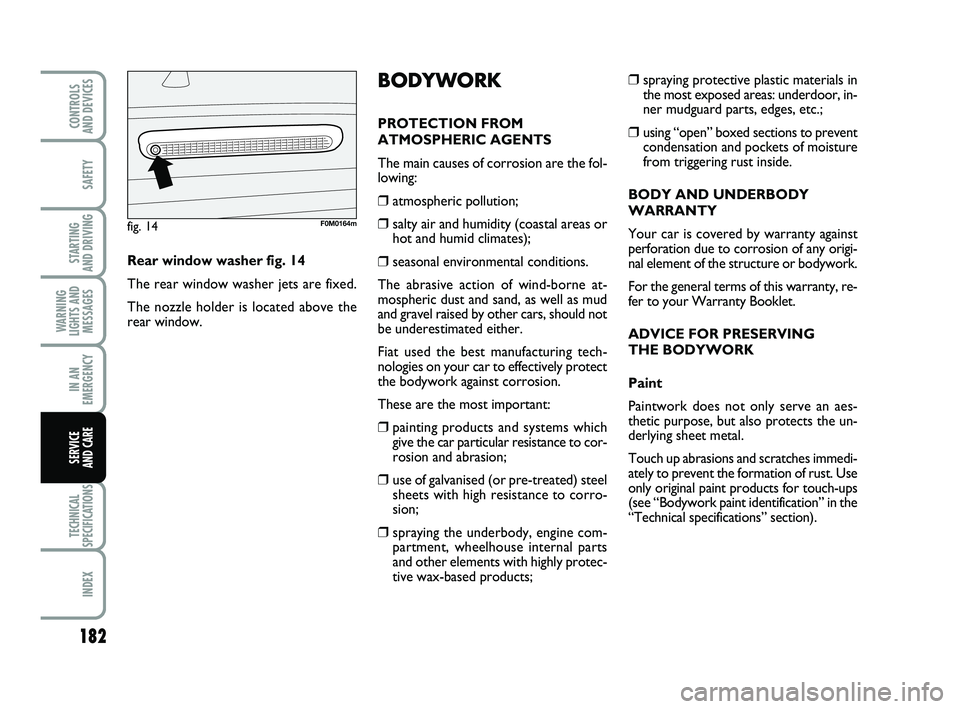
182
SAFETY
STARTING
AND DRIVING
WARNING
LIGHTS AND MESSAGES
IN AN
EMERGENCY
TECHNICAL
SPECIFICATIONS
INDEX
CONTROLS
AND DEVICES
SERVICE
AND CARE
❒spraying protective plastic materials in the most exposed areas: underdoor, in-
ner mudguard parts, edges, etc.;
❒using “open” boxed sections to preventcondensation and pockets of moisture
from triggering rust inside.
BODY AND UNDERBODY
WARRANTY
Your car is covered by warranty against
perforation due to corrosion of any origi-
nal element of the structure or bodywork.
For the general terms of this warranty, re-
fer to your Warranty Booklet.
ADVICE FOR PRESERVING
THE BODYWORK
Paint
Paintwork does not only serve an aes-
thetic purpose, but also protects the un-
derlying sheet metal.
Touch up abrasions and scratches immedi-
ately to prevent the formation of rust. Use
only original paint products for touch-ups
(see “Bodywork paint identification” in the
“Technical specifications” section).
BODYWORK
PROTECTION FROM
ATMOSPHERIC AGENTS
The main causes of corrosion are the fol-
lowing:
❒atmospheric pollution;
❒salty air and humidity (coastal areas or hot and humid climates);
❒seasonal environmental conditions.
The abrasive action of wind-borne at-
mospheric dust and sand, as well as mud
and gravel raised by other cars, should not
be underestimated either.
Fiat used the best manufacturing tech-
nologies on your car to effectively protect
the bodywork against corrosion.
These are the most important:
❒painting products and systems which give the car particular resistance to cor-
rosion and abrasion;
❒use of galvanised (or pre-treated) steelsheets with high resistance to corro-
sion;
❒spraying the underbody, engine com-partment, wheelhouse internal parts
and other elements with highly protec-
tive wax-based products;
Rear window washer fig. 14
The rear window washer jets are fixed.
The nozzle holder is located above the
rear window.
fig. 14F0M0164m
165-184 PUNTO POP 1ed EN 07/04/14 09:35 Pagina 182
Page 187 of 219
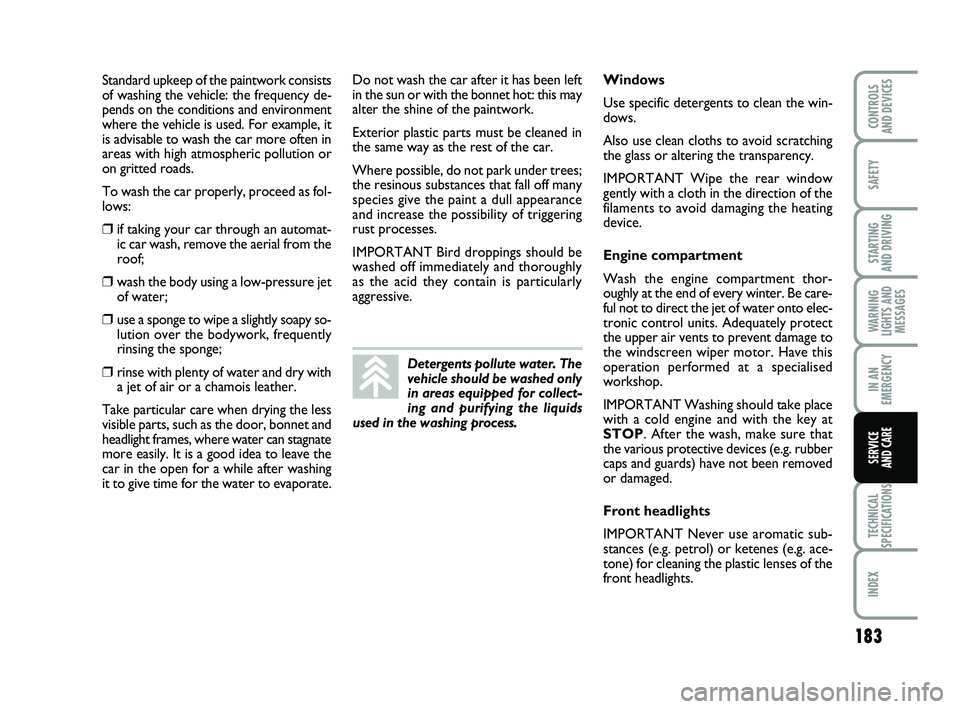
183
SAFETY
STARTING
AND DRIVING
WARNING
LIGHTS AND MESSAGES
IN AN
EMERGENCY
TECHNICAL
SPECIFICATIONS
INDEX
CONTROLS
AND DEVICES
SERVICE
AND CARE
Standard upkeep of the paintwork consists
of washing the vehicle: the frequency de-
pends on the conditions and environment
where the vehicle is used. For example, it
is advisable to wash the car more often in
areas with high atmospheric pollution or
on gritted roads.
To wash the car properly, proceed as fol-
lows:
❒if taking your car through an automat- ic car wash, remove the aerial from the
roof;
❒wash the body using a low-pressure jetof water;
❒use a sponge to wipe a slightly soapy so-lution over the bodywork, frequently
rinsing the sponge;
❒rinse with plenty of water and dry witha jet of air or a chamois leather.
Take particular care when drying the less
visible parts, such as the door, bonnet and
headlight frames, where water can stagnate
more easily. It is a good idea to leave the
car in the open for a while after washing
it to give time for the water to evaporate. Do not wash the car after it has been left
in the sun or with the bonnet hot: this may
alter the shine of the paintwork.
Exterior plastic parts must be cleaned in
the same way as the rest of the car.
Where possible, do not park under trees;
the resinous substances that fall off many
species give the paint a dull appearance
and increase the possibility of triggering
rust processes.
IMPORTANT Bird droppings should be
washed off immediately and thoroughly
as the acid they contain is particularly
aggressive.Detergents pollute water. The
vehicle should be washed only
in areas equipped for collect-
ing and purifying the liquids
used in the washing process.
Windows
Use specific detergents to clean the win-
dows.
Also use clean cloths to avoid scratching
the glass or altering the transparency.
IMPORTANT Wipe the rear window
gently with a cloth in the direction of the
filaments to avoid damaging the heating
device.
Engine compartment
Wash the engine compartment thor-
oughly at the end of every winter. Be care-
ful not to direct the jet of water onto elec-
tronic control units. Adequately protect
the upper air vents to prevent damage to
the windscreen wiper motor. Have this
operation performed at a specialised
workshop.
IMPORTANT Washing should take place
with a cold engine and with the key at
STOP. After the wash, make sure that
the various protective devices (e.g. rubber
caps and guards) have not been removed
or damaged.
Front headlights
IMPORTANT Never use aromatic sub-
stances (e.g. petrol) or ketenes (e.g. ace-
tone) for cleaning the plastic lenses of the
front headlights.
165-184 PUNTO POP 1ed EN 07/04/14 09:35 Pagina 183
Page 188 of 219
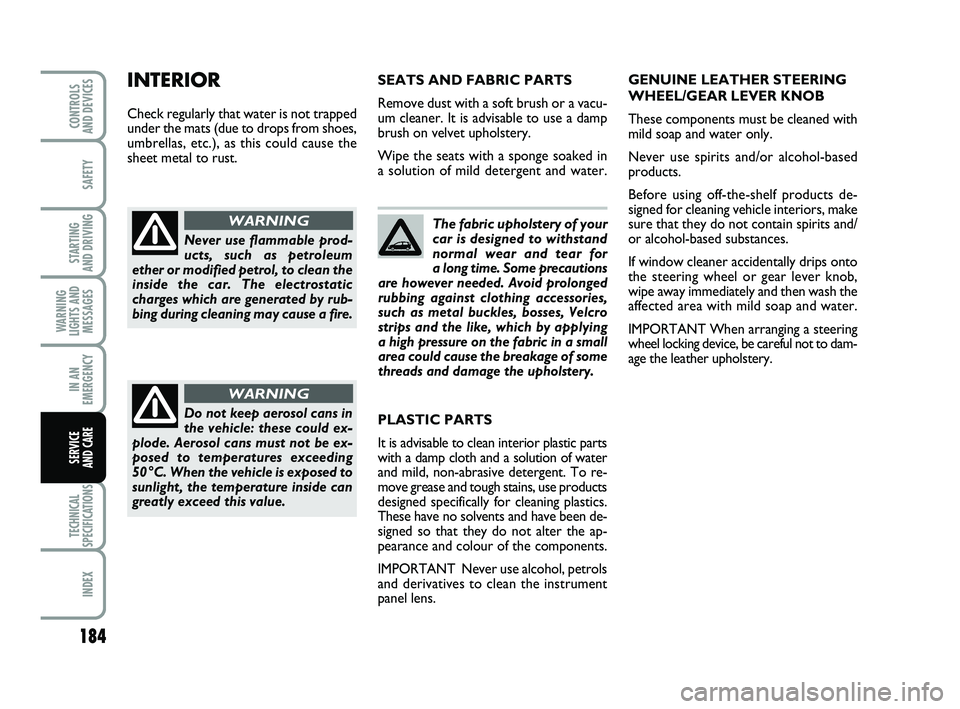
184
SAFETY
STARTING
AND DRIVING
WARNING
LIGHTS AND MESSAGES
IN AN
EMERGENCY
TECHNICAL
SPECIFICATIONS
INDEX
CONTROLS
AND DEVICES
SERVICE
AND CARE
The fabric upholstery of your
car is designed to withstand
normal wear and tear for
a long time. Some precautions
are however needed. Avoid prolonged
rubbing against clothing accessories,
such as metal buckles, bosses, Velcro
strips and the like, which by applying
a high pressure on the fabric in a small
area could cause the breakage of some
threads and damage the upholstery.
SEATS AND FABRIC PARTS
Remove dust with a soft brush or a vacu-
um cleaner. It is advisable to use a damp
brush on velvet upholstery.
Wipe the seats with a sponge soaked in
a solution of mild detergent and water.
Never use flammable prod-
ucts, such as petroleum
ether or modified petrol, to clean the
inside the car. The electrostatic
charges which are generated by rub-
bing during cleaning may cause a fire.
WARNING
Do not keep aerosol cans in
the vehicle: these could ex-
plode. Aerosol cans must not be ex-
posed to temperatures exceeding
50 °C. When the vehicle is exposed to
sunlight, the temperature inside can
greatly exceed this value.
WARNING
INTERIOR
Check regularly that water is not trapped
under the mats (due to drops from shoes,
umbrellas, etc.), as this could cause the
sheet metal to rust. GENUINE LEATHER STEERING
WHEEL/GEAR LEVER KNOB
These components must be cleaned with
mild soap and water only.
Never use spirits and/or alcohol-based
products.
Before using off-the-shelf products de-
signed for cleaning vehicle interiors, make
sure that they do not contain spirits and/
or alcohol-based substances.
If window cleaner accidentally drips onto
the steering wheel or gear lever knob,
wipe away immediately and then wash the
affected area with mild soap and water.
IMPORTANT When arranging a steering
wheel locking device, be careful not to dam-
age the leather upholstery.
PLASTIC PARTS
It is advisable to clean interior plastic parts
with a damp cloth and a solution of water
and mild, non-abrasive detergent. To re-
move grease and tough stains, use products
designed specifically for cleaning plastics.
These have no solvents and have been de-
signed so that they do not alter the ap-
pearance and colour of the components.
IMPORTANT Never use alcohol, petrols
and derivatives to clean the instrument
panel lens.
165-184 PUNTO POP 1ed EN 07/04/14 09:35 Pagina 184
Page 189 of 219
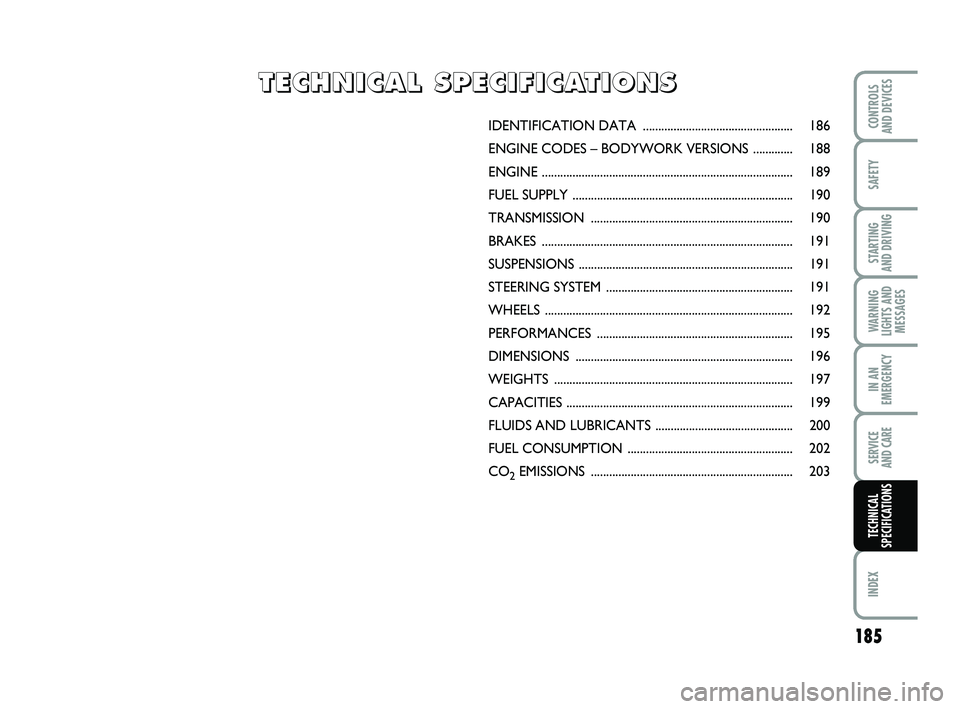
185
SAFETY
STARTING
AND DRIVING
WARNING
LIGHTS AND MESSAGES
IN AN
EMERGENCY
SERVICE
AND CARE
INDEX
CONTROLS
AND DEVICES
TECHNICAL
SPECIFICATIONS
IDENTIFICATION DATA ................................................. 186
ENGINE CODES – BODY WORK VERSIONS ............. 188
ENGINE ........................................................................\
.......... 189
FUEL SUPPLY ......................................................................\
.. 190
TRANSMISSION .................................................................. 190
BRAKES .......................................................................\
........... 191
SUSPENSIO NS .....................................................................\
. 191
STEERING SYSTEM ............................................................. 191
WHEELS ........................................................................\
......... 192
PERFORMANCES ................................................................ 195
DIMENSIONS .......................................................................\
196
WEIGHTS ........................................................................\
...... 197
CAPACIT IES ........................................................................\
.. 199
FLUIDS AND LU BRICANTS ............................................. 200
FUEL CONSUMPT ION ...................................................... 202
CO
2EMISSIONS .................................................................. 203
T
T
E
E
C
C
H
H
N
N
I
I
C
C
A
A
L
L
S
S
P
P
E
E
C
C
I
I
F
F
I
I
C
C
A
A
T
T
I
I
O
O
N
N
S
S
185-206 PUNTO POP 1ed EN 24/03/14 13:52 Pagina 185
Page 190 of 219
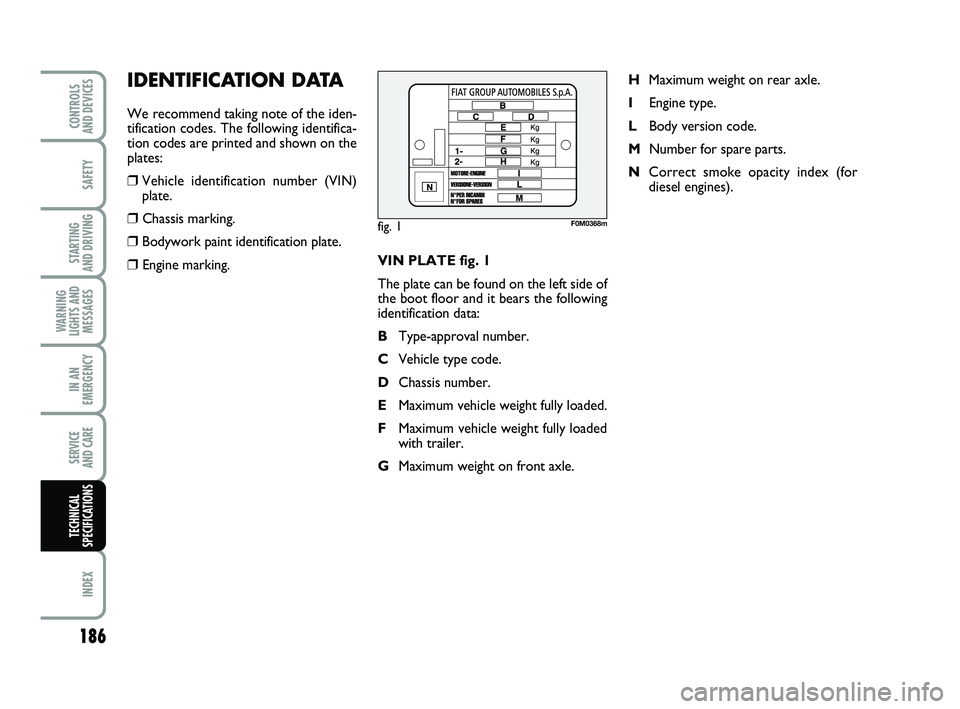
186
SAFETY
STARTING
AND DRIVING
WARNING
LIGHTS AND MESSAGES
IN AN
EMERGENCY
SERVICE
AND CARE
INDEX
CONTROLS
AND DEVICES
TECHNICAL
SPECIFICATIONS
VIN PLATE fig. 1
The plate can be found on the left side of
the boot floor and it bears the following
identification data:
B Type-approval number.
C Vehicle type code.
D Chassis number.
E Maximum vehicle weight fully loaded.
F Maximum vehicle weight fully loaded
with trailer.
G Maximum weight on front axle. H
Maximum weight on rear axle.
I Engine type.
L Body version code.
M Number for spare parts.
N Correct smoke opacity index (for
diesel engines).
IDENTIFICATION DATA
We recommend taking note of the iden-
tification codes. The following identifica-
tion codes are printed and shown on the
plates:
❒Vehicle identification number (VIN)
plate.
❒Chassis marking.
❒Bodywork paint identification plate.
❒Engine marking.
fig. 1F0M0368m
185-206 PUNTO POP 1ed EN 24/03/14 13:52 Pagina 186